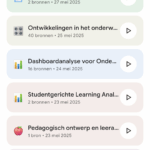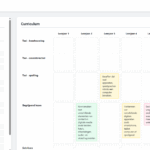 Een van de aardige features van een Google Scholar profiel is dat je ook alerts kunt aanmaken op basis van je eigen artikelen. Je krijgt dan een seintje als er een nieuwe publicatie verschenen is die naar een van jouw publicaties verwijst. Niet altijd zijn die dan zomaar vrij te downloaden.
Een van de aardige features van een Google Scholar profiel is dat je ook alerts kunt aanmaken op basis van je eigen artikelen. Je krijgt dan een seintje als er een nieuwe publicatie verschenen is die naar een van jouw publicaties verwijst. Niet altijd zijn die dan zomaar vrij te downloaden.
De literatuurstudie “Student Use of Recorded Lectures: A report reviewing recent research into the use of lecture capture technology in higher education, and its impact on teaching methods and attendance” (PDF!) is echter gewoon online beschikbaar, dus kan ik er ook naar verwijzen.
In de literatuurstudie wordt verwezen naar een aantal onderzoeken op dit gebied, waaronder het artikel dat hoofdstuk 3 vormt van mijn promotieonderzoek.
De conclusies van de literatuurstudie zijn als het goed is geen echte verrassing:
The papers reviewed in this report, whilst using varying measurement parameters and studying different groups of students studying a variety of courses, have reached some common conclusions on the questions of student use of recorded lectures and its effect on attendance. The majority of these papers concluded that students liked having access to recorded lectures, and mainly used them to make up for missed lectures, and to review lectures in order to prepare for assessments (Soong et al. 2006; Traphagan et al. 2009; Gosper et al. 2008). Students in most studies also preferred access to live lectures, with most preferring a blended format incorporating lecture recordings, live lectures, course materials and additional classes. Studies have suggested that lecture capture may also be a helpful tool for students with learning disabilities (Giliberti et al. 2012) and NESB students (Shaw & Molnar, 2011). Therefore, there is scope for further research into the use of recorded lectures by these students.
The perception that access to recorded lectures lowered student attainment has also been disputed by most of the papers considered in this review, with lecture recordings having a slightly positive, or negligible effect on student attainment, and even a rise in student grades and lecture attendance in some cases (Franklin et al. 2011). This may be due to the strategic manner in which students use lecture recordings to reinforce their understanding of lecture material, rather than viewing recordings as a replacement for attending lectures.
Whilst access to recorded lectures was reported to be the reason for some students being absent at live lectures, attendance could have been affected by a range of factors, including the level of student maturity and natural declines in student attendance over time. There seems to be little evidence that having access to recorded lectures is the main cause or incentive to miss lectures. In fact, the majority of students (55%) surveyed by Traphagan et al. (2009) strongly agreed that they preferred receiving lecture content in class, even when it is available through other means. Massingham & T. Herrington (2006), found that illness or competing priorities such as work or other lectures were more cited reasons for students missing lectures than availability of recorded lectures. However, Massingham & T. Herrington (2006) also note that “students only attend lectures if they perceive ‘value’ in them”, and having access to lecture recordings is unlikely to have an effect on classes which are not generally valued by students.
Therefore, whilst lecture capture technology offers many benefits and pitfalls, its current role in higher education remains a supportive one in relation to live lectures, which are yet valued higher by students than their recorded equivalents.



